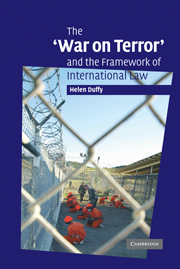Book contents
- Frontmatter
- Contents
- Preface and acknowledgements
- Table of abbreviations
- Table of cases
- Table of conventions
- 1 Introduction
- PART ONE
- PART TWO
- PART THREE
- 6 International humanitarian law
- 7 International human rights law
- 8 Case study – Guantanamo Bay detentions under international human rights and humanitarian law
- 9 Conclusion
- Bibliography
- Index
6 - International humanitarian law
Published online by Cambridge University Press: 06 August 2009
- Frontmatter
- Contents
- Preface and acknowledgements
- Table of abbreviations
- Table of cases
- Table of conventions
- 1 Introduction
- PART ONE
- PART TWO
- PART THREE
- 6 International humanitarian law
- 7 International human rights law
- 8 Case study – Guantanamo Bay detentions under international human rights and humanitarian law
- 9 Conclusion
- Bibliography
- Index
Summary
I observed that men rushed to war for slight causes or no causes at all, and that arms have once been taken up there is no longer any respect for law, divine or human.
Hugo Grotius, 1625The legal framework
Earlier parts of this book have focused on the characterisation of the September 11 attacks and explored which responses may be lawful within the international legal framework, including the criminal law response and the circumstances in which it is lawful for states to resort to armed force. This part, by contrast, addresses the rules that limit how these responses may be executed.
The focus is on the law applicable once there has been a resort to force, and an armed conflict has arisen. This law (the jus in bello) applies irrespective of whether the use of force is itself lawful (according to the jus ad bellum, addressed at Chapter 5). The rules that govern armed conflict derive from a branch of international law, known as international humanitarian law (IHL), that comes into play in armed conflict, addressed in this chapter, and a core of international human rights law that applies in all situations, addressed in the next.
IHL applies in ‘armed conflict’ and imposes constraints on how that conflict may be waged. Its objective is to protect certain persons who do not (or no longer) take part in hostilities and to limit the methods and means of warfare for the benefit of all.
- Type
- Chapter
- Information
- The 'War on Terror' and the Framework of International Law , pp. 217 - 273Publisher: Cambridge University PressPrint publication year: 2005

